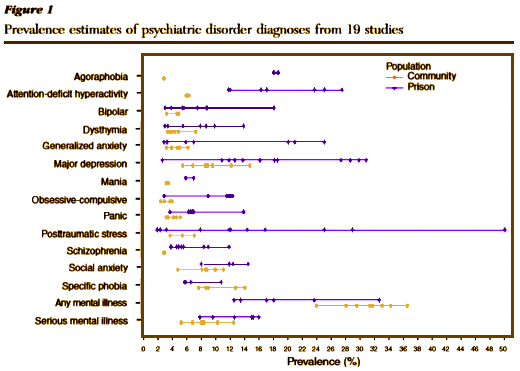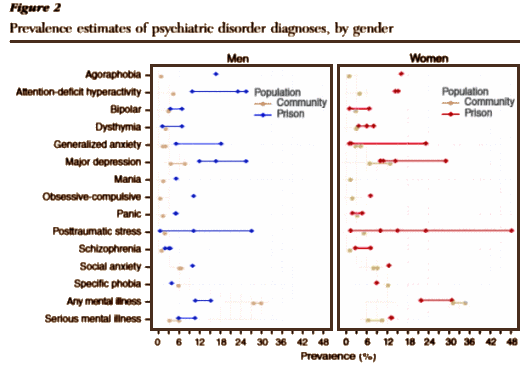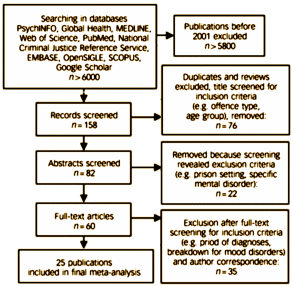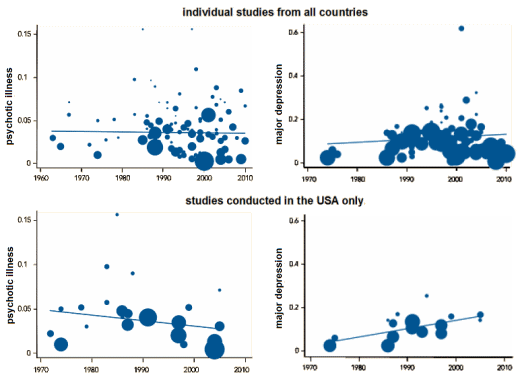This is where we left off:
by Seth J. Prins, M.P.H.Psychiatric Services. 2014 65:862-872.Objective: People with mental illnesses are understood to be over-represented in the U.S. criminal justice system, and accurate prevalence estimates in corrections settings are crucial for planning and implementing preventive and diversionary policies and programs. Despite consistent scholarly attention to mental illness in corrections facilities, only two federal self-report surveys are typically cited, and they may not represent the extent of relevant data. This systematic review was conducted to develop a broader picture of mental illness prevalence in U.S. state prisons and to identify methodological challenges to obtaining accurate and consistent estimates.Methods: MEDLINE, PsycINFO, the National Criminal Justice Reference Service, Social Services Abstracts, Social Work Abstracts, and Sociological Abstracts were searched. Studies were included if they were published between 1989 and 2013, focused on U.S. state prisons, reported prevalence of diagnoses and symptoms of DSM axis I disorders, and identified screening and assessment strategies.Conclusions: Definitions of mental illnesses, sampling strategies, and case ascertainment strategies likely contributed to inconsistency in findings. Other reasons for study heterogeneity are discussed, and implications for public health are explored.
[These are a colorized versions of his figures with lots of tailoring to make them fit, but I think they are at least a reasonable fascimile of his findings for just looking over, but if you’re really interested, get the original. Each diamond represents the results of one of the studies he looked at.]


We don’t have any choice here but to start with his methods in detail:
Methods: A systematic review of the scholarly literature was conducted to identify studies that presented prevalence estimates of mental illnesses in prisons. Articles were included if they were published in peer-reviewed, English-language journals between January 1989 and December 2013, focused on U.S. state prisons, reported prevalence estimates of diagnoses or symptoms of DSM axis I disorders, and clearly identified the denominator for prevalence proportions.Articles were excluded if they did not present original data; focused solely on axis II disorders, youths, jails, or foreign prisons; selected samples only of people with mental illnesses or substance use disorders; presented only combined jail and prison prevalence estimates; did not present prevalence estimates [for example, presented only mean scale scores or odds ratios for disorders]; or the denominator for prevalence estimates was not apparent. Samples selected on the basis of substance use were excluded given the high rates at which substance use disorders co-occur with mental illnesses among incarcerated individuals, which would therefore not provide good estimates of mental illnesses per se. A review of the prevalence of substance use disorders in prisons was beyond the scope of this report.MEDLINE, PsycINFO, the National Criminal Justice Reference Service, Social Services Abstracts, Social Work Abstracts, and Sociological Abstracts were searched. For MEDLINE and PsycINFO, combinations of the following medical subject headings [MeSH] were used: mental disorders, mental health, prevalence, incidence, epidemiology, psychotropic drugs, drug therapy, prisons, and prisoners. For the remaining databases, similar keyword combinations, including axis I disorder terms, were searched…The initial search yielded 3,670 non-duplicated articles. Based on titles and abstracts, 3,388 articles did not meet inclusion criteria and were excluded… Full texts of the 282 remaining articles were reviewed, and an additional 254 studies were rejected based on exclusion criteria outlined above… Twenty-eight articles were thus included in the review…
First off, I think Seth Prins is a real scientist. He took a relatively large unmanageable literature, clipped it down to size using the usually solid techniques of analysis, and presented it without "dolling it up." But 3670-»3388-»282-»28 is quite a bit of paring down, and leaves us with questions about what this sample actually represents. The variability among the studies is equally striking. But that’s not his doing. It’s what he found to work with. Most of his in-depth discussion is about the many sources of variability in his findings and are too much for a blog post, but his message is clear, and I buy it. Debates, opinions, policies, and public dollars are riding on the numbers of mentally ill people in our prisons, why they are there, and how they got there. We need a whole lot better data than we have to make evidence-based decisions about how to proceed. He mentions some instruments that might help in doing that, though I’m unfamiliar with them [I expect most of us are]:
As such, accurately measuring the prevalence of mental illnesses “inside the walls” is essential for community corrections planning. Given the existence of brief, well-validated instruments that screen for mental illnesses, such as the Brief Jail Mental Health Screen, K6, and Correctional Mental Health Screen, reporting standards for routine assessments upon intake are clearly feasible. Even in the absence of such standards, prison administrators, working in collaboration with mental health policy makers and practitioners, can [at relatively low cost] calibrate such screening instruments to their populations and begin collecting valid and reliable prevalence estimates.
In my own dancing around through this literature over the last week or so, I’ve been finding the same thing Prins found in his formal analysis – heterogeneity². There are innumerable local studies, specific to certain areas, places, kind of detention facility, etc, but when I aim for the big picture, what I find is researchers struggling to do some kind of meta-analysis with widely divergent methodologies [big surveys with questionnaires or small focused studies with precise instruments]. This next one is a world-wide study, that’s actually an update from a previous meta-analysis and has broken out the US data longitudinally [and it’s available on-line]:
Severe mental illness in 33,588 prisoners worldwide: systematic review and meta-regression analysis.by Fazel S and Seewald KBritish Journal of Psychiatry. 2012 200[5]:364-373.
BACKGROUND: High levels of psychiatric morbidity in prisoners have been documented in many countries, but it is not known whether rates of mental illness have been increasing over time or whether the prevalence differs between low-middle-income countries compared with high-income ones.AIMS: To systematically review prevalence studies for psychotic illness and major depression in prisoners, provide summary estimates and investigate sources of heterogeneity between studies using meta-regression.METHOD: Studies from 1966 to 2010 were identified using ten bibliographic indexes and reference lists. Inclusion criteria were unselected prison samples and that clinical examination or semi-structured instruments were used to make DSM or ICD diagnoses of the relevant disorders.RESULTS: We identified 109 samples including 33 588 prisoners in 24 countries. Data were meta-analysed using random-effects models, and we found a pooled prevalence of psychosis of 3.6% [95% CI 3.1-4.2] in male prisoners and 3.9% [95% CI 2.7-5.0] in female prisoners. There were high levels of heterogeneity, some of which was explained by studies in low-middle-income countries reporting higher prevalences of psychosis [5.5%, 95% CI 4.2-6.8; P = 0.035 on meta-regression]. The pooled prevalence of major depression was 10.2% [95% CI 8.8-11.7] in male prisoners and 14.1% [95% CI 10.2-18.1] in female prisoners. The prevalence of these disorders did not appear to be increasing over time, apart from depression in the USA [P = 0.008].CONCLUSIONS: High levels of psychiatric morbidity are consistently reported in prisoners from many countries over four decades. Further research is needed to confirm whether higher rates of mental illness are found in low- and middle-income nations, and examine trends over time within nations with large prison populations.
As with Prins, first to the methods:
Method: We identified publications estimating the prevalence of psychotic disorders [including psychosis, schizophrenia, schizophreniform disorders, manic episodes] and major depression among prisoners that were published between 1 January 1966 and 31 December 2010. For the period 1 January 1966 to 31 December 2000, methods are described in a previous systematic review conducted by one of the authors. For the update and expanded review, from 1 January 2001 to 31 December 2010, we used the following databases: PsycINFO, Global Health, MEDLINE, Web of Science, PubMed, National Criminal Justice Reference Service, EMBASE, OpenSIGLE, SCOPUS, Google Scholar, scanned references and corresponded with experts in the field. Key words used for the database search were the following: mental*, psych*, prevalence, disorder, prison*, inmate, jail, and also combinations of those. Non-English language articles were translated. We followed PRISMA criteria. Inclusion criteria were the: [a] study population was sampled from a general prison population; [b] diagnoses of the relevant disorders were made by clinical examination or by interviews using validated diagnostic instruments; [c] diagnoses met standardised diagnostic criteria for psychiatric disorders based on the ICD or the DSM; [d] prevalence rates were provided for the relevant disorders in the previous 6 months.
The full text version on-line has a comparison of the actual studies. Notice that the numbers fall here too – down to 25 different studies. Their method, like Prins, looked only at papers where diagnosis was made by interview. Their significant findings were higher rates of severe mental illness in prison in low income countries; an increasing prevalence of Major Depressive Disorder over time in the US; but no increase in the prevalence of psychosis in the US prison population. If anything, it fell.

So, what about transinstitutionalization?…
The prevalence of PTSD doesn’t surprise me.
If you haven’t seen this already, you might be interesting in some of the Choosing Wisely recommendations in psychiatry. It’s a start to ending some harmful and unhelpful practices.
http://www.choosingwisely.org/doctor-patient-lists/american-psychiatric-association/
My brain hurts.
This raises so many questions I do not know how to place them in order of importance.
Lower income areas produce more crime, but this is not a function of ability since we see such people as Dr. Ben Carson and others rising above those impediments. Recent studies also show that in the US people move up and down the income ladder.
Is MDD a function of income, doctor bias, or is there some other factor that makes this population more susceptible to this condition.
Where is the really good data on this issue going to come from, or are we dealing with yet another urban myth. It was announced yesterday the government is canceling a study on the environment and children after spending over $1B and never being able to produce a viable design. This may be a more pressing issue.
Steve Lucas